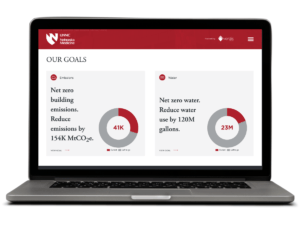Put your data at the center of the decision-making process. Our dashboards connect you to your data and communicate your sustainability progress.
Feedback loops to make timely, data-informed decisions and communicate impact
A highly effective organization evolves with the flow of information. Creating a feedback loop of data helps organizations make timely, data-informed decisions. We collect and analyze data, then use our suite of dashboards to communicate the most important information to the right audiences. Our dashboards also enable you to be transparent and convey your sustainability journey to your community.

Standard Dashboards
Transparent. These public-facing dashboards enable you to communicate your sustainability journey. Share your efforts with key parties by showing your commitment to helping meet global climate goals. By openly communicating with key parties, you can foster trust and drive organizational growth.
Customizable. Our customizable Standard Dashboards let you display the status of your Key Indicators in your sustainability journey. Share your accomplishments and progress toward your climate goals.
- Presents data in a simple format for key parties
- Communicates your sustainability impact
- Displays your commitment to helping meet global climate goals
- Track progress towards sustainability goals
- Completely customizable

Premium Dashboards
Data-Informed. Our intuitive Premium Dashboards streamline information management for greenhouse gas emissions and empower you to analyze key data, track emissions, and make data-informed decisions.
Customizable. Our Premium Dashboards are fully customizable, allowing you to measure, review, and report your sustainability data in a personalized, efficient way. With a dashboard, you can extract unique insights to inform data-driven strategies that optimize your decision-making and maximize your positive impact.
- Empowers your organization to make informed decisions on climate action
- Allows easy access to granular data at anytime
- Conduct cross-comparisons of data based on type, location, and more
- Track progress towards sustainability goals
- Completely customizable
Let’s talk!
To view our Premium Dashboards, contact us today.
